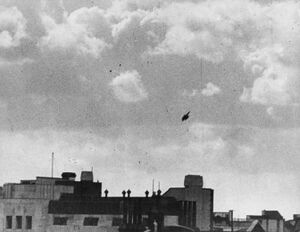Operation K-1
| Operation K-1 | |
|---|---|
| Part of the Battle of Lucis of the Second Europan War | |
 Đinh's Damlier Da 17 falling over Elizabeth Station | |
| Type | Aerial bombing |
| Location | |
| Planned by | Quenminese Naval Air Marshal Uất Xuân Minh and Reichsmarschall Helmar Göring |
| Target | Dettingen Palace |
| Date | 15 September 1939 10:00 – 12:00 |
| Executed by | |
| Outcome | Allied Victory
Imperial Operational Failure
|
| Casualties | 3 Quenminese Planes
1 Lucian Hopkins Hurricane
|
Operation K-1 also known as the Imperial Plot to Kill the Royal Family, or known to the Lucian public as The Miraculous Collision was an operation carried out on 15 September 1939 during Battle of Lucis Day, in which the Aerial Campaign over Lucis reached its climax. The attempt was personally thought of by Quenminese Emperor Hiep Mang, who suggested to Imperial Emperor Maximilian I that the way the loss of the royal family would demoralize the Lucis Empire and Commonwealth into surrender, which was mostly accepted by many Imperial planners.
The operation was carried out by members of the Imperial Quenminese Air Force, manning Imperial planes with a payload enough to destroy Dettingen Palace and ensure that everything around it was destroyed. It was carried out around 10am in the morning. However, No. 505 RAF Squadron engaged in a bitter fight over Insomnia against Imperial planes of the Kampfgeschwader 106 and the Archadian Aerio Gruppo Corpo 104. The three planes manned by Quenminese crews from the former disengaged and attempted to carry the bombing attempt. However, RAF Flight Lieutenant Richard Holmes spotted the three planes attempting to make a bombing run on Central Insomnia and engaged them. The first bomber nearly destroyed his plane, but was reinforced by RAF FLt. Rick Dundy and his wingman, who downed the first plane. He then engaged the second plane, shooting the fuel tanks and watching the plane burst in flames in mid-air, exploding a few seconds later. The third plane was a few kilometers away from the Palace. Holmes swung to the side in an attempt to destroy it, only to discover that his machine guns jammed. Holmes decided to ram the bomber hoping his plane could withstand the impact and cut through it. He flew his plane into the top-side of the bomber, cutting off the rear tail section with his wing. Of the 7 crews, only two survived by bailing out. They were immediately captured and sent away.
The aftermath saw the failure of the plot, in which the Imperial command opted to never do the operation again. The two Quenminese crewmen confessed that it was a genuine Imperial plan. The ramming became one of the most famous photographs of the Battle of Lucis. RAF Flight Lieutenant Richard Holmes was feted as a war hero by the press for saving Dettingen Palace and was awarded with the highest Commonwealth award for bravery, the Georgius Cross personally by King Regis Lucis Caelum CVIII.
The events that happened were immortalized in the 1974 film The Man Who Saved The King, and was remade in 2021.